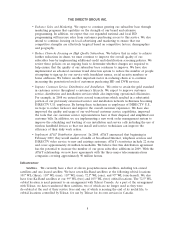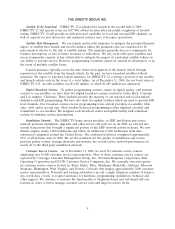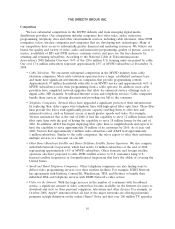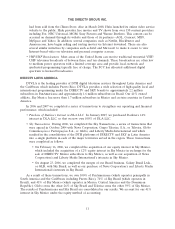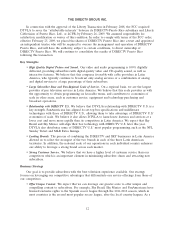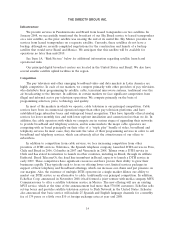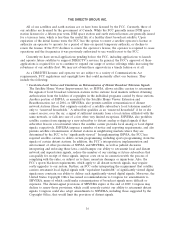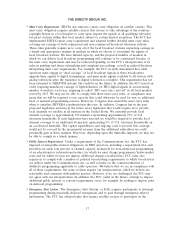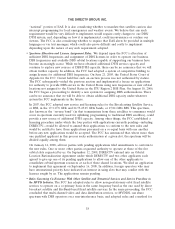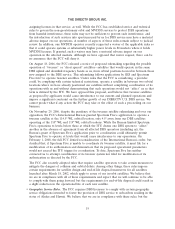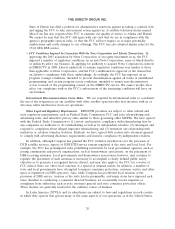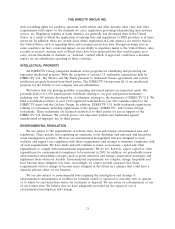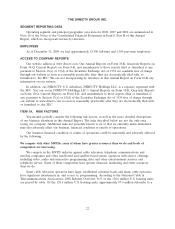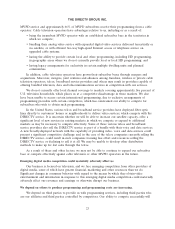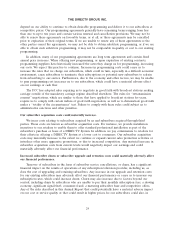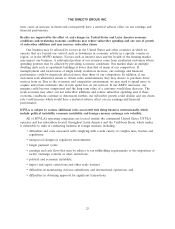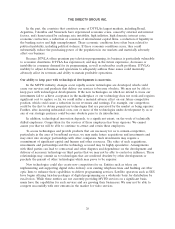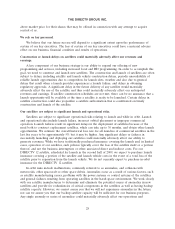DIRECTV 2008 Annual Report Download - page 31
Download and view the complete annual report
Please find page 31 of the 2008 DIRECTV annual report below. You can navigate through the pages in the report by either clicking on the pages listed below, or by using the keyword search tool below to find specific information within the annual report.THE DIRECTV GROUP, INC.
‘‘national’’ portion of EAS. It is also considering whether to mandate that satellite carriers also
interrupt programming for local emergencies and weather events. We believe that any such
requirement would be very difficult to implement, would require costly changes to our DBS/
DTH system, and, depending on how it is implemented, could inconvenience or confuse our
viewers. The FCC is also considering whether to require that EAS alerts be provided in multiple
languages or via text messages, which could also prove difficult and costly to implement
depending upon the nature of any such requirement adopted.
•Spectrum Allocation and License Assignment Rules. We depend upon the FCC’s allocation of
sufficient DBS frequencies and assignment of DBS licenses in order to operate our business.
DBS frequencies and available DBS orbital locations capable of supporting our business have
become increasingly scarce. While we have obtained additional DTH service capacity and
continue to explore new sources of DBS/DTH capacity, there can be no assurance that we will
obtain further capacity. In addition, the FCC had adopted a system of competitive bidding to
assign licenses for additional DBS frequencies. On June 21, 2005, the United States Court of
Appeals for the D.C. Circuit held that such an auction process was not authorized by statute.
The FCC subsequently voided the previous auction and implemented a freeze on applications
for authority to provide DBS service in the United States using new frequencies or new orbital
locations not assigned to the United States in the ITU Region 2 BSS Plan. On August 18, 2006,
the FCC began a proceeding to identify a new system for assigning DBS authorizations. There
can be no assurance that we will be able to obtain additional DBS capacity under whatever
system the FCC implements in the future.
In 2007, the FCC adopted new service and licensing rules for the Broadcasting Satellite Service,
or BSS, in the 17.3-17.8 GHz and 24.75-25.25 GHz bands, or 17/24 GHz BSS. This spectrum,
also known as the ‘‘reverse band’’ (in that transmissions from these satellites to consumers would
occur in spectrum currently used for uplinking programming to traditional DBS satellites), could
provide a new source of additional DTH capacity. Among other things, the FCC established a
licensing procedure under which the four parties with applications currently pending—including
DIRECTV—would be allowed to amend their applications to conform to the new rules and
would be entitled to have those applications processed on a co-equal basis with one another
before any new applications would be accepted. The FCC has announced that, where more than
one qualified applicant in this process seeks authorization at a given slot, the spectrum will be
divided equally among them.
On January 14, 2008, all four parties with pending applications filed amendments to conform to
the new rules. One or more other parties requested authority to operate at three of the five
orbital slots requested by us. On September 12, 2008, DIRECTV entered into an Orbital
Location Rationalization Agreement under which DIRECTV and two other applicants each
agreed to give up one of its pending applications to allow one of the other applicants to
consolidate orbital/spectrum resources at each of three shared locations. We filed an application
to implement this agreement on September 16, 2008. In addition, foreign operators who may
have international priority have indicated an interest in using slots that may conflict with the
licenses sought by us. The applications remain pending.
•Rules Governing Co-Existence With Other Satellite and Terrestrial Services and Service Providers in
the MVPD Industry. The FCC has adopted rules to allow non-geostationary orbit fixed satellite
services to operate on a co-primary basis in the same frequency band as the one used by direct
broadcast satellite and Ku-Band-based fixed satellite services. In the same proceeding, the FCC
concluded that multi-channel video and data distribution services, or MVDDS, can share
spectrum with DBS operators on a non-interference basis, and adopted rules and a method for
18


